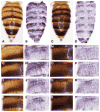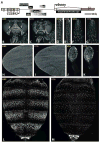Stepwise modification of a modular enhancer underlies adaptation in a Drosophila population
- PMID: 20019281
- PMCID: PMC3363996
- DOI: 10.1126/science.1178357
Stepwise modification of a modular enhancer underlies adaptation in a Drosophila population
Abstract
The evolution of cis regulatory elements (enhancers) of developmentally regulated genes plays a large role in the evolution of animal morphology. However, the mutational path of enhancer evolution--the number, origin, effect, and order of mutations that alter enhancer function--has not been elucidated. Here, we localized a suite of substitutions in a modular enhancer of the ebony locus responsible for adaptive melanism in a Ugandan Drosophila population. We show that at least five mutations with varied effects arose recently from a combination of standing variation and new mutations and combined to create an allele of large phenotypic effect. We underscore how enhancers are distinct macromolecular entities, subject to fundamentally different, and generally more relaxed, functional constraints relative to protein sequences.
Figures





Comment in
-
Evolution. Spineless fish and dark flies prove gene regulation crucial.Science. 2009 Dec 18;326(5960):1612. doi: 10.1126/science.326.5960.1612. Science. 2009. PMID: 20019263 No abstract available.
References
-
- Carroll SB, Grenier JK, Weatherbee SD. From DNA to Diversity: Molecular Genetics and the Evolution of Animal Design. 2. Blackwell; Malden, MA: 2005.
-
- Davidson EH. The Regulatory Genome: Gene Regulatory Networks in Development and Evolution. Academic Press; Burlington, MA: 2006. p. xi.
-
- Gompel N, Prud’homme B, Wittkopp PJ, Kassner VA, Carroll SB. Nature. 2005;433481 - PubMed
-
- Prud’homme B, et al. Nature. 2006;4401050
-
- Jeong S, Rokas A, Carroll SB. Cell. 2006;1251387 - PubMed
Publication types
MeSH terms
Substances
Associated data
- Actions
- Actions
- Actions
- Actions
- Actions
- Actions
- Actions
- Actions
- Actions
- Actions
- Actions
- Actions
- Actions
- Actions
- Actions
- Actions
- Actions
- Actions
- Actions
- Actions
- Actions
- Actions
- Actions
- Actions
- Actions
- Actions
- Actions
- Actions
- Actions
- Actions
- Actions
- Actions
- Actions
- Actions
- Actions
- Actions
- Actions
- Actions
- Actions
- Actions
- Actions
- Actions
- Actions
- Actions
- Actions
- Actions
- Actions
- Actions
- Actions
- Actions
- Actions
- Actions
- Actions
- Actions
- Actions
- Actions
- Actions
- Actions
- Actions
- Actions
- Actions
- Actions
- Actions
- Actions
- Actions
- Actions
- Actions
- Actions
- Actions
- Actions
- Actions
- Actions
- Actions
- Actions
- Actions
- Actions
- Actions
- Actions
- Actions
- Actions
- Actions
- Actions
- Actions
- Actions
- Actions
- Actions
- Actions
- Actions
- Actions
- Actions
- Actions
- Actions
- Actions
- Actions
- Actions
- Actions
- Actions
- Actions
- Actions
- Actions
- Actions
- Actions
- Actions
- Actions
- Actions
- Actions
- Actions
- Actions
- Actions
- Actions
- Actions
- Actions
- Actions
- Actions
- Actions
- Actions
- Actions
- Actions
- Actions
- Actions
- Actions
- Actions
- Actions
- Actions
- Actions
- Actions
- Actions
Grants and funding
LinkOut - more resources
Full Text Sources
Other Literature Sources
Molecular Biology Databases

